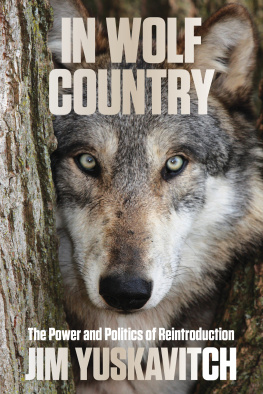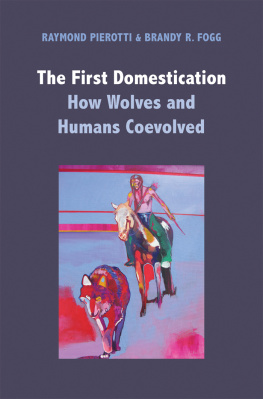Robert H. Busch - Wolf Almanac: A Celebration of Wolves and Their World
Here you can read online Robert H. Busch - Wolf Almanac: A Celebration of Wolves and Their World full text of the book (entire story) in english for free. Download pdf and epub, get meaning, cover and reviews about this ebook. year: 2018, publisher: Lyons Press, genre: Science. Description of the work, (preface) as well as reviews are available. Best literature library LitArk.com created for fans of good reading and offers a wide selection of genres:
Romance novel
Science fiction
Adventure
Detective
Science
History
Home and family
Prose
Art
Politics
Computer
Non-fiction
Religion
Business
Children
Humor
Choose a favorite category and find really read worthwhile books. Enjoy immersion in the world of imagination, feel the emotions of the characters or learn something new for yourself, make an fascinating discovery.

- Book:Wolf Almanac: A Celebration of Wolves and Their World
- Author:
- Publisher:Lyons Press
- Genre:
- Year:2018
- Rating:5 / 5
- Favourites:Add to favourites
- Your mark:
- 100
- 1
- 2
- 3
- 4
- 5
Wolf Almanac: A Celebration of Wolves and Their World: summary, description and annotation
We offer to read an annotation, description, summary or preface (depends on what the author of the book "Wolf Almanac: A Celebration of Wolves and Their World" wrote himself). If you haven't found the necessary information about the book — write in the comments, we will try to find it.
The newly revised reference work on the history and evolution of wolves, their biology and physiology, behavior and sociology, and their mythology.
Wolf Almanac: A Celebration of Wolves and Their World — read online for free the complete book (whole text) full work
Below is the text of the book, divided by pages. System saving the place of the last page read, allows you to conveniently read the book "Wolf Almanac: A Celebration of Wolves and Their World" online for free, without having to search again every time where you left off. Put a bookmark, and you can go to the page where you finished reading at any time.
Font size:
Interval:
Bookmark:
Robert H. Busch is the author of eight books on natural history, including the The Cougar Almanac. His writing has appeared in Nature Canada, Wildlife Conservation, Discovery, and Country Journal. The reviser for this edition is Jim Yuskavitch, the author of In Wolf Country.
Thanks are due to the numerous individuals who provided information for this almanac: Rene Askins, The Wolf Fund; Norman Bishop, U.S. National Park Service; Dave Burke, U.S. Fish and Wildlife Service (USFWS); Lu Carbyn, Canadian Wildlife Service (CWS); Nancy Checko, Algonquin Provincial Park; Colleen Clark, Wolf Haven International; Lou Feiring, The Living Desert; Pattie Fowler, Arizona-Sonora Desert Museum; Steven Fritts, USFWS; Nancy Gray, Great Smoky Mountains National Park; Dan Groebner, Arizona Game and Fish Department; Bobbie Holaday, Preserve Arizonas Wolves (PAWS); Minette Johnson, Defenders of Wildlife; Bud Lensing, Mexican Wolf Coalition; Susan Lyndaker Lindsey, Wild Canal Survival and Research Center; Bjrn Ljunggren, Freningen Varggruppen; Byron Mason, Trophy Wildlife Records Club of British Columbia; Pat McGary, Defenders of Wildlife; Mike Phillips, USFWS; Christoph Promberger, Euronatur; Will Waddell, Point Defiance Zoo and Aquarium; Deborah Warrick, Wildlife Rehabilitation Center Sanctuary; Laura Wasson, Humane Society of the United States; and the dozens of provincial, state, and federal wildlife agencies that kindly provided statistics from their files. Hannah Barron of Earthroots and Sadie Parr of Wolf Awareness, Inc. provided extensive help in compiling hunting, trapping, and wolf control data for the Canada provinces.
And to Peter Burford, my thanks for his conception of this project and for his faith in my work.
The Endangered Species Act (ESA) of 1973 is a strong tool for the protection of American endangered species. A species may be listed as endangered: in danger of extinction throughout all or a significant portion of its range; or as threatened: likely to become endangered within the near future without protection. The gray wolf is listed as endangered in all lower 48 states except for Minnesota, where it is listed as threatened. The gray wolf is deemed to be stable within Alaska.
The ESA contains two sets of prohibitions against actions that may affect a listed species. The first is the so-called no-jeopardy standard in Section 7.
Section 7: This section imposes obligations on federal agencies that deal with the listed species. First, it imposes the obligation on those agencies to conserve threatened and endangered species. Second, those agencies must insure that actions authorized, funded, or carried out by an agency are not likely to jeopardize the continued existence of any (listed) species or result in the destruction or adverse modification of the species critical habitat.
The act requires that stringent precautions be taken before any federal agency commits any action that may affect a listed species. The agency must first determine whether a listed species may be present in an area and then whether that species is likely to be affected by the proposed action. If so, the agency must consult with the USFWS to obtain a written opinion on whether the proposal will jeopardize the listed species.
All activities requiring federal funding, authorization, or permits are subject to these Section 7 requirements.
The second is Section 9, a group of restrictions on any person or entity taking, harming, or harassing an endangered species.
Section 9: This section states that it is illegal for any person subject to the jurisdiction of the United States to take an endangered species. The term take is broadly defined as harass, harm, pursue, hunt, shoot, wound, kill, trap, capture, or collect, or attempt to engage in any such conduct. Any activity that negatively affects the normal behavior of a listed species is prohibited. In at least one instance, the alteration of habitat critical to the recovery of a listed species has been deemed to constitute taking.
Any violation of a prohibition involving a listed species subjects the individual or entity to fines up to $50,000 and one year in jail. Additional civil penalties of up to $25,000 may also be assessed, and all federal permits and licenses possessed by the individual or entity are revoked.
The only exception to this section is a clause allowing otherwise prohibited activities for scientific purposes or to enhance the propagation or survival of the affected species. The act also allows exceptions in documented cases of self-defense against the listed species. The secretary of the interior may also allow the taking of a threatened species if it is deemed necessary and advisable to provide for the conservation of that species.
Other clauses: The ESA requires all federal agencies to further the conservation of endangered species. The term conservation is defined as the use of all methods and procedures which are necessary to bring any endangered or threatened species to the point at which the measures provided pursuant to this Act are no longer necessary.
The act also generally requires that the secretary of the interior develop any and all plans to achieve the delisting of a listed species.
A 1982 amendment to the ESA allows the designation of introduced populations as experimental, which allows greater flexibility in their biological and political management.
This manifesto on wolf conservation, along with recommended guidelines for conservation, was adopted by the International Union for the Conservation of Nature and Natural Resources Wolf Specialist Group at its meeting in Stockholm, Sweden, in 1973. It has been endorsed by the Survival Service Commission and the Executive Board of IUCN.
The 1973 meeting was attended by delegates and observers from twelve countries that had significant wolf populations.
DECLARATION OF PRINCIPLES FOR WOLF CONSERVATION
Wolves, like all other wildlife, have a right to exist in a wild state. This right is in no way related to their known value to mankind. Instead, it derives from the right of all living creatures to co-exist with man as part of the natural ecosystems.
The wolf pack is a highly developed and unique social organization. The wolf is one of the most adaptable and important mammalian predators. It has one of the widest natural geographical distributions of any mammal. It has been, and in some cases still is, the most important predator of big-game animals in the northern hemisphere. In this role, it has undoubtedly played an important part in the evolution of such species and, in particular, of those characteristics which have made many of them desirable game animals.
It is recognized that wolf populations have differentiated into subspecies which are genetically adapted to particular environments. It is of first importance that these local populations be maintained in their natural environments in a wild state. Maintenance of genetic purity of locally adapted races is a responsibility of agencies which plan to reintroduce wolves into the wild as well as zoological gardens that may prove a source for such reintroductions.
Throughout recorded history man has regarded the wolf as undesirable and has sought to exterminate it. In more than half of the countries of the world where the wolf existed, man has either succeeded, or is on the verge of succeeding, in exterminating the wolf.
This harsh judgment on the wolf has been based first on fear of the wolf as a predator of man and second on hatred because of its predation on domestic livestock and on large wild animals. Historical perspectives suggest that to a considerable extent the first fear has been based on myth rather than on fact. It is now evident that the wolf can no longer be considered a serious threat to man. It is true, however, that the wolf has been, and in some cases, still is, a predator of some consequence on domestic livestock and wildlife.
Font size:
Interval:
Bookmark:
Similar books «Wolf Almanac: A Celebration of Wolves and Their World»
Look at similar books to Wolf Almanac: A Celebration of Wolves and Their World. We have selected literature similar in name and meaning in the hope of providing readers with more options to find new, interesting, not yet read works.
Discussion, reviews of the book Wolf Almanac: A Celebration of Wolves and Their World and just readers' own opinions. Leave your comments, write what you think about the work, its meaning or the main characters. Specify what exactly you liked and what you didn't like, and why you think so.








